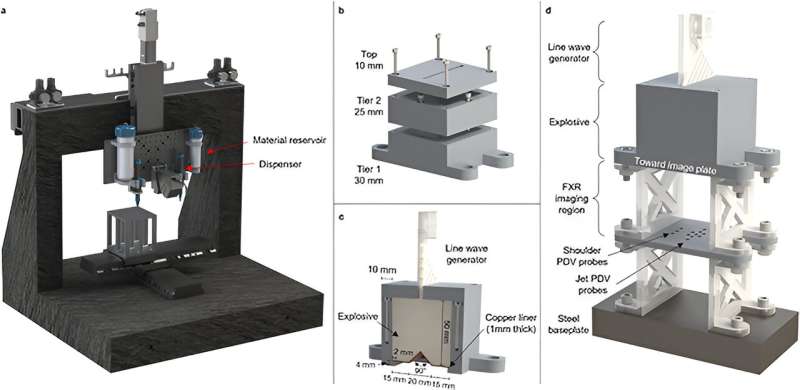
MAY 13, 2024 by Shelby Conn, Lawrence Livermore National Laboratory
Collected at : https://phys.org/news/2024-05-optimized-high-explosives.html
When materials are subjected to extreme environments, they face the risk of mixing together. This mixing may result in hydrodynamic instabilities, yielding undesirable side effects. Such instabilities present a grand challenge across multiple disciplines, especially in astrophysics, combustion and shaped charges—a device used to focus the energy of a detonating explosive, thereby creating a high velocity jet that is capable of penetrating deep into metal, concrete or other target materials.
To address the challenges in controlling these instabilities, researchers at Lawrence Livermore National Laboratory (LLNL) are coupling computing capabilities and manufacturing methods to rapidly develop and experimentally validate modifications to a shaped charge. This work, published in the Journal of Applied Physics, is a part of Project DarkStar—a Laboratory Directed Research and Development strategic initiative aimed at controlling material deformation by investigating the scientific problems of complex hydrodynamics, shockwave physics and energetic materials.
“Like a hurricane, shock waves and the detonation of explosives are typically deemed ‘uncontrollable’ events. But we have made it our goal to control these complicated dynamical systems,” said DarkStar’s principal investigator Jon Belof.
The inspiration behind project DarkStar is deeply rooted in an unfinished line of research by Johnny von Neumann—a key member of the Manhattan Project and an expert in the nonlinear physics of hydrodynamics and shock waves. Having contributed to LLNL’s world-leading reputation in computing, von Neumann is often considered the most gifted mathematician of his time.
Applying modern technologies to von Neumann’s computational theories, the team employed artificial intelligence (AI) and machine learning (ML) to explore new, computationally optimized designs. The use of additive manufacturing—3D printing—made it possible for researchers to rapidly realize even the most radical AI-designed components that would otherwise be considered “impossible” to create using traditional manufacturing methods.
To test their shaped charge designs—comprising a copper liner, a high explosive (HE) and a silicone buffer—the team conducted a total of 14 HE detonation experiments at LLNL’s High Explosives Applications Facility from 2022 to 2023. These experiments compared a baseline design, which did not utilize a buffer between the liner and the HE, against a design with an optimized buffer to demonstrate the effectiveness of the silicone buffer as an instability mitigation technique.
“Each of our designs went through optimization, manufacturing and detonation testing in less than three months,” said lead author Dylan Kline.
Once detonated, the metal liner is compressed and squeezed forward at about 5 kilometers per second, forming a high-velocity jet. The instability that this research aims to mitigate takes place when the explosive creates an impulse or “spike” at the materials interface, deforming and accelerating the metal (which has a high density) into the air around it (which has a low density). In this case, the instability or mixing of materials takes place when the jet forms in the air.
Kline said, “Our goal is to augment how this instability grows. If we can add something in our design to shape the shock waves, then we can control the way that energy is imparted on the metal liner.”
Flash X-ray radiographs taken during the detonation experiments reveal the silicone buffer’s ability to mitigate potential instabilities reliably and consistently.
Through their series of experiments, the team has uncovered several ground-breaking discoveries regarding hydrodynamic instabilities, including how to completely suppress an instability known as the Richtmyer–Meshkov Instability (RMI). RMI is of particular interest due to its unpredictable nature and role in materials undergoing extreme dynamic loading.
This research is directly applicable to aerospace engineering and energy and climate security, as shaped charges are typically used for separating aircraft systems or for closing oil pipes in emergency situations. For example, during the Deepwater Horizon oil spill in 2010, a shaped charge would normally have been used to quickly close the pipe. However, because pressures were so high, even explosives were ineffective at stopping the spill.
“This is just one case where having more powerful explosives and more effective ways of using them to manipulate metal could improve our industrial ecology,” Belof said.
Project DarkStar illuminates the potential of AI/ML to support a wide range of national security missions.
More information: Dylan J. Kline et al, Reducing Richtmyer–Meshkov instability jet velocity via inverse design, Journal of Applied Physics(2024). DOI: 10.1063/5.0180712
Journal information: Journal of Applied Physics

Leave a Reply